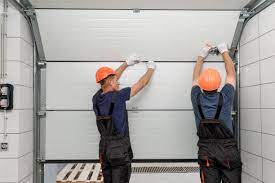Garage doors are complex systems made up of various components that work together to ensure smooth and efficient operation. Understanding the individual parts of a garage door can help homeowners recognize potential issues, perform basic maintenance, and make informed decisions about repairs or replacements. This guide provides an overview of the essential garage door parts and their functions.
1. Garage Door Panels
• Function: The panels are the large sections that make up the surface of the garage door. They are typically constructed from materials such as steel, wood, aluminum, or fiberglass.
• Importance: Panels provide the primary structure of the door and contribute to its aesthetic appeal. They also play a role in insulation and energy efficiency.
2. Garage Door Springs
• Types: There are two main types of springs used in garage doors: torsion springs and extension springs.
o Torsion Springs: Mounted above the door, these springs are responsible for counterbalancing the door’s weight, making it easier to open and close.
o Extension Springs: Located on either side of the door, these springs stretch and contract to support the door’s weight as it moves.
• Importance: Springs are crucial for the smooth operation of the door. They bear the majority of the door’s weight and require regular inspection and maintenance to prevent failures.
3. Garage Door Opener
• Function: The opener is the motorized device that controls the opening and closing of the garage door. It is usually mounted on the ceiling of the garage.
• Types: There are several types of garage door openers, including chain-drive, belt-drive, and screw-drive systems.
o Chain-Drive Openers: Known for their durability and cost-effectiveness, they use a chain to move the door.
o Belt-Drive Openers: These are quieter and use a rubber belt for smooth operation.
o Screw-Drive Openers: These use a metal rod to lift and lower the door and are known for their minimal maintenance requirements.
• Importance: The opener is the central component for automated operation and convenience. It includes safety features like auto-reverse systems to prevent accidents.
4. Garage Door Tracks
• Function: Tracks guide the movement of the garage door as it opens and closes. They are mounted vertically on the sides of the door frame and horizontally along the ceiling.
• Importance: Properly aligned tracks ensure smooth and stable movement of the door. Misalignment or obstruction in the tracks can lead to operational issues and potential damage.
5. Rollers
• Function: Rollers are small wheels that fit into the tracks and help the door move smoothly. They are typically made of steel or plastic.
• Importance: Well-maintained rollers reduce friction and noise, contributing to the door’s smooth operation. Regular lubrication and inspection of rollers are essential for maintaining performance.
6. Hinges
• Function: Hinges connect the individual panels of the garage door, allowing them to flex and move as the door opens and closes.
• Importance: Hinges must be sturdy and properly aligned to ensure that the door operates smoothly and without issues. Worn or damaged hinges can cause the door to operate unevenly or become misaligned.
7. Cables
• Function: Cables work in conjunction with the springs to lift and lower the garage door. They are attached to the bottom corners of the door and run through pulleys.
• Importance: Cables are under significant tension and play a critical role in balancing the door. Regular inspection is necessary to check for fraying or damage.
8. Weatherstripping
• Function:Weatherstripping is installed along the edges of the garage door to seal gaps and protect against drafts, water, and debris.
• Importance: Proper weatherstripping helps maintain energy efficiency, keep out pests, and protect the door from environmental damage. It should be checked regularly and replaced if worn or damaged.
9. Sensors
• Function: Safety sensors are located near the bottom of the door tracks and detect obstacles in the door’s path.
• Importance: These sensors are crucial for preventing accidents by automatically reversing the door if an object is detected. They enhance the safety of the garage door system and require regular testing to ensure proper functionality.
Conclusion
Understanding the various parts of a Garage door parts system is essential for effective maintenance and troubleshooting. Each component, from the panels and springs to the opener and sensors, plays a specific role in ensuring smooth operation and safety. Regular inspections and maintenance of these parts can help extend the lifespan of your garage door, enhance its performance, and prevent unexpected issues. By staying informed about the function and importance of each component, homeowners can better manage their garage door system and address potential problems before they escalate.
Understanding Garage Door Parts: A Comprehensive Guide

Categories:

